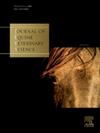频谱多普勒超声不能识别有睾丸功能障碍的种马
IF 1.3
3区 农林科学
Q2 VETERINARY SCIENCES
引用次数: 0
摘要
本回顾性研究旨在验证谱多普勒超声诊断种马睾丸功能障碍的有效性。研究的第一部分包括一匹与年龄相关的睾丸变性(18 - 21岁)的矮种马。旧的)。连续4年多次获得该小马睾丸尺寸、睾丸血流谱多普勒参数和精液参数。当睾丸体积急剧减小,无精子时,除TABF率(Total Arterial blood flow rate)外,睾丸血流频谱多普勒参数均无变化。TABF率逐渐升高,很可能是由于睾丸体积的显著减少。在研究的第二部分,4匹种马(5 - 8岁)的医疗记录。本文回顾分析了老年患者睾丸功能障碍(TDF)的临床特点。评估的参数包括睾丸尺寸、睾丸血流谱多普勒参数和精液参数。5种可育种马(FR)作为TDF种马的参考。除TABF显著高于TDF外,FR种与TDF种的睾丸血流频谱多普勒参数均无显著差异(P <;0005)。这可能是由FR种的睾丸动脉直径较大引起的。然而,当考虑单个种马时,FR和TDF种马的TABF值重叠。基于本研究结果,我们认为频谱多普勒超声并不总是诊断种马睾丸功能障碍的可靠方法。本文章由计算机程序翻译,如有差异,请以英文原文为准。
The inability of spectral Doppler ultrasonography to identify stallions with testicular dysfunction
This retrospective study aimed to validate the usefulness of spectral Doppler ultrasonography in diagnosing testicular dysfunction in stallions. The first part of the study included a pony stallion with age-related testicular degeneration (18 – 21 yrs. old). Testicular dimensions, spectral Doppler parameters of testicular blood flow, and semen parameters were obtained numerous times from this pony over four consecutive years. While testicular volume decreased dramatically, and the stallion became azoospermic, there were no changes in any of the spectral Doppler parameters of testicular blood flow, except the TABF rate (Total Arterial Blood Flow rate). TABF rate gradually increased, most likely due to a significant decrease in testicular volume. In the second part of the study, medical records of four horse stallions (5 – 8 yrs. old) with testicular dysfunction (TDF) were reviewed and analyzed. Parameters evaluated included testicular dimensions, spectral Doppler parameters of testicular blood flow, and semen parameters. Five fertile stallions (FR) served as the reference for TDF stallions. There were no significant differences between FR and TDF stallions in any of the spectral Doppler parameters of testicular blood flow, except TABF, which was significantly higher in FR stallions than in TDF stallions (P < 0,005). This was likely caused by the larger testicular artery diameter in FR stallions. However, when individual stallions were considered, the values of the TABF overlapped between FR and TDF stallions. Based on the results of this study, we conclude that spectral Doppler ultrasonography is not always a reliable method for diagnosing testicular dysfunction in stallions.
求助全文
通过发布文献求助,成功后即可免费获取论文全文。
去求助
来源期刊

Journal of Equine Veterinary Science
农林科学-兽医学
CiteScore
2.70
自引率
7.70%
发文量
249
审稿时长
77 days
期刊介绍:
Journal of Equine Veterinary Science (JEVS) is an international publication designed for the practicing equine veterinarian, equine researcher, and other equine health care specialist. Published monthly, each issue of JEVS includes original research, reviews, case reports, short communications, and clinical techniques from leaders in the equine veterinary field, covering such topics as laminitis, reproduction, infectious disease, parasitology, behavior, podology, internal medicine, surgery and nutrition.
 求助内容:
求助内容: 应助结果提醒方式:
应助结果提醒方式:


